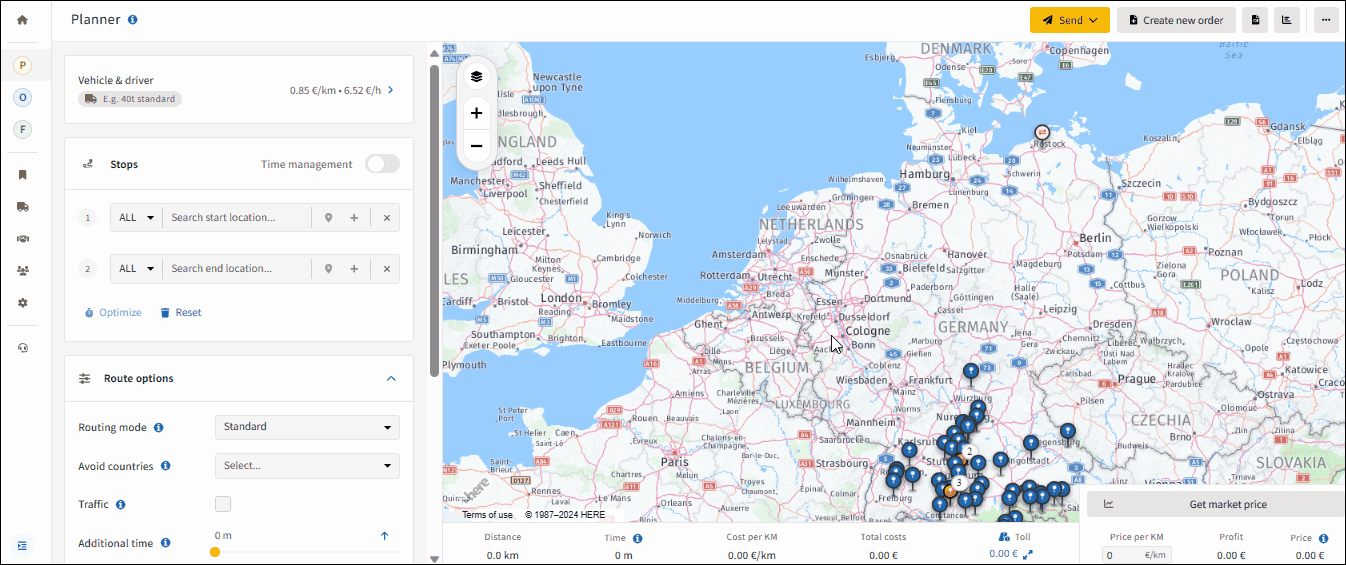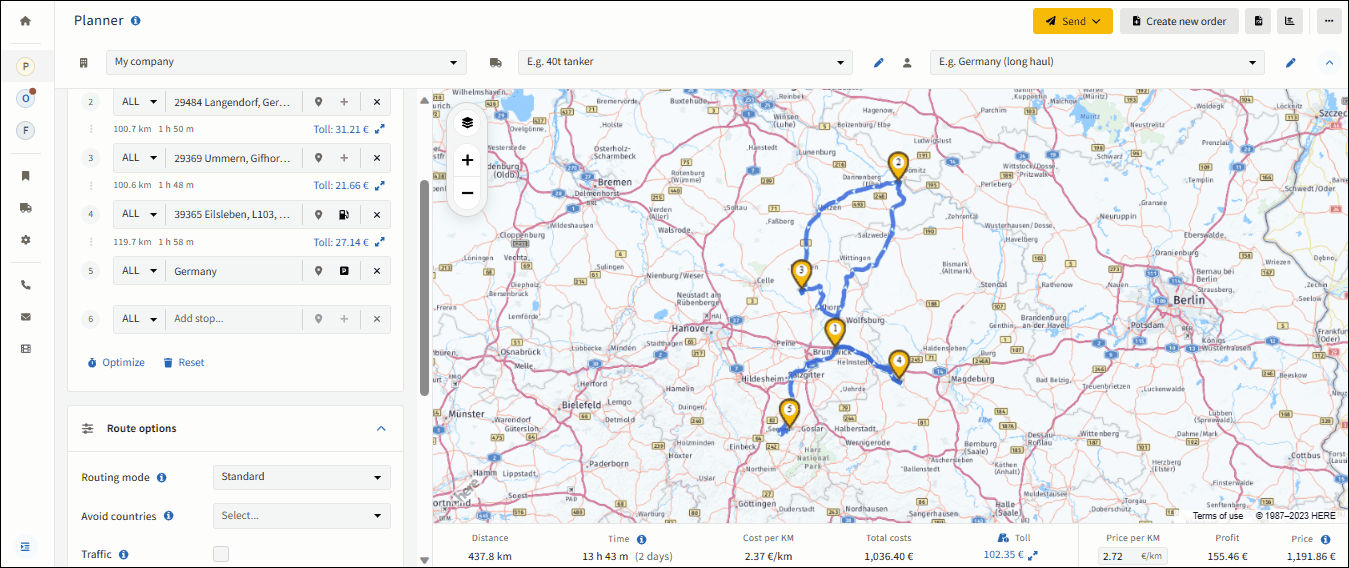- What is FTL Freight in Trucking Logistics?
- Explanation of FTL Freight
- Example Scenario For FTL Transportation
- Key Strategies for FTL Freight Transport
- Example Scenario For FTL Strategies
- FTL Freight Software Solutions
- When to Use FTL Transport Services
- FTL Management System (TMS)
What is FTL Transport?
Full Truck Load (FTL) transport is the optimal shipping method for businesses with large shipment volumes. Unlike Less Than Truckload (LTL) shipping, FTL dedicates an entire truck to a single shipment, ensuring faster delivery times, enhanced security, and cost savings.
Explanation of FTL Freight
Imagine you have a large shipment of products that completely fills a truck's capacity, such as a whole truckload of furniture. Instead of sharing truck space with other shippers and making multiple stops to load and unload other goods (as in Less Than Truckload or LTL shipping), the entire truck is reserved just for your furniture. This truck will pick up your shipment and drive directly to your destination without making any other stops.
Example Scenario For FTL Transportation
A large retailer in Europe needs to send a full truckload of new seasonal clothing from a distribution center in Berlin, Germany, to a store in Paris, France. Using FTL freight, the retailer books a truck that will carry only their shipment. The truck is loaded with the clothing at the distribution center in Berlin and drives straight to the store in Paris, ensuring the entire load arrives quickly, safely, and efficiently.

Key Strategies for FTL Freight Transport
1. Optimize Route Planning
Effective route planning is crucial for FTL freight. Use advanced logistics software to plan the most efficient routes. This helps in reducing transit times and fuel costs. Consider factors such as traffic patterns, road conditions, and weather forecasts to minimize delays.
2. Utilize Real-Time Tracking
Implement GPS tracking systems to monitor your shipments in real-time. This provides visibility into the truck’s location and estimated arrival time, allowing for better coordination and communication with your customers. Real-time tracking also helps in quickly addressing any issues that may arise during transit.
3. Maximize Load Efficiency
Ensure your truck is fully loaded to optimize costs. Collaborate with your logistics provider to calculate the most efficient way to pack and load your goods. This not only maximizes space utilization but also reduces the number of trips required, saving time and money.
4. Schedule Regular Maintenance
Regular maintenance of your fleet ensures that trucks are in optimal condition for long hauls. Preventive maintenance helps avoid unexpected breakdowns, ensuring that your shipments arrive on time. You will also need to calculate your maintenance costs, making sure all costs are accounted for. Work with reliable maintenance providers and schedule routine checks for your vehicles.
5. Leverage Data Analytics
Use data analytics to gain insights into your freight operations. Analyze historical data to identify trends and areas for improvement. This can include optimizing delivery times, reducing fuel consumption, and improving load efficiency. Data-driven decisions help in enhancing overall transport performance.
6. Build Strong Relationships with Carriers
Develop strong partnerships with reliable carriers. Building good relationships ensures that you get priority service, competitive rates, and flexible scheduling options. Work with carriers that have a proven track record of reliability and efficiency.
7. Implement Sustainable Practices
Adopt sustainable practices in your FTL transport operations. This can include using fuel-efficient trucks, optimizing routes to reduce fuel consumption, and exploring alternative fuels. Sustainability not only benefits the environment but can also lead to cost savings and improved brand reputation.

Example Scenario For FTL Strategies
A European electronics company needs to transport a full truckload of new gadgets from its manufacturing plant in Prague, Czech Republic, to a distribution center in Madrid, Spain. By employing the above strategies, the company:
- Uses advanced route planning software to find the fastest and most fuel-efficient route, considering current road conditions and weather forecasts.
- Implements GPS tracking to monitor the truck’s journey in real-time, providing updates to the distribution center and customers.
- Optimizes the truck’s load capacity by carefully planning the packing process to ensure every inch of space is utilized efficiently.
- Schedules regular maintenance checks for its fleet to avoid breakdowns during the long haul.
- Analyzes data from previous shipments to identify the best times for loading and unloading, ensuring a smooth operation.
- Works closely with a reliable carrier that has a strong reputation for on-time deliveries.
- Adopts sustainable practices by using a fuel-efficient truck and planning the route to minimize fuel consumption.
FTL Freight Software Solutions
FTL (Full Truckload) transport software solutions are designed to optimize the management, execution, and monitoring of full truckload shipments. These solutions offer a range of features to improve logistics efficiency, reduce costs, and enhance overall service quality. Here are some key components and benefits of FTL transport software solutions:
1. Load Planning and Optimization
FTL transport software provides advanced load planning and optimization tools. These features help businesses maximize truck capacity, reduce empty miles, and minimize transportation costs by efficiently planning and consolidating shipments.
2. Talk to Our Software Experts
Book a free demo, and receive personalized consultation on your transport operations. We will discuss how a TMS can improve customer satisfaction with accurate delivery estimates and proactive communication, ensure regulatory compliance, and seamlessly integrate with your existing software.
3. Real-Time Tracking and Visibility
FTL transport software solutions offer real-time tracking and visibility of shipments. Businesses can monitor the location of their trucks, track delivery progress, and receive real-time updates on any delays or issues, ensuring timely deliveries and improved customer satisfaction.
4. Automated Dispatch and Routing
Automated dispatch and routing features allow businesses to streamline their operations. The software uses real-time data and advanced routing algorithms to optimize delivery routes, reduce fuel consumption, and minimize travel time, leading to cost savings and increased efficiency.
5. Freight Rate Management
FTL transport software solutions often include freight rate management capabilities. These tools allow businesses to compare rates from multiple carriers, negotiate better rates, and select the most cost-effective options for their shipments.
6. Order and Fleet Management
With integrated order and fleet management capabilities, FTL transport software helps businesses manage their transport orders and fleet operations from a single platform. This includes tracking orders, managing driver assignments, and monitoring vehicle maintenance.
7. Automated Notifications and Alerts
FTL transport software provides automated notifications and alerts to keep stakeholders informed. Customers receive updates on shipment status and expected delivery times, while internal teams are alerted to any potential issues or delays, allowing for proactive management.
8. Reporting and Analytics
These software solutions offer robust reporting and analytics features. Businesses can generate detailed reports on key performance indicators (KPIs), such as delivery times, fuel consumption, and freight costs. Analytics tools help identify areas for improvement and drive data-driven decision-making.
9. Integration with Other Systems
FTL transport software can integrate with other business systems, such as ERP (Enterprise Resource Planning), WMS (Warehouse Management Systems), and CRM (Customer Relationship Management) systems. This integration ensures seamless data flow and enhances overall operational efficiency.
10. Enhanced Customer Experience
By leveraging FTL transport software, businesses can provide a better customer experience. The software enables accurate delivery estimates, real-time shipment tracking, and timely communication, all of which contribute to higher customer satisfaction.
11. Scalability and Flexibility
FTL transport software solutions are scalable and flexible, allowing businesses to adapt to changing needs and growth. Whether managing a small fleet or a large network of shipments, these tools can accommodate varying levels of complexity and scale.
12. Compliance and Safety Management
FTL transport software solutions often include features for managing compliance and safety regulations. This ensures that all shipments adhere to industry standards and legal requirements, reducing the risk of penalties and enhancing overall safety.
13. Document Management
FTL transport software can streamline document management by digitizing and automating the handling of shipping documents, invoices, and other paperwork. This reduces administrative burdens and improves accuracy and efficiency in managing documentation.
When to Use FTL Transport Services
FTL (Full Truckload) transport is an ideal shipping solution in various scenarios where businesses need to move large quantities of goods. Here are specific situations when using FTL transport is advantageous:
1. Large Shipment Sizes
When the volume of goods to be shipped is large enough to fill an entire truck, FTL transport is the most cost-effective and efficient option. This avoids the complexities and potential delays associated with consolidating multiple smaller shipments.
2. Time-Sensitive Shipments
FTL transport is ideal for shipments that need to be delivered quickly. Since the truck travels directly from the origin to the destination without intermediate stops, transit times are shorter and more predictable.
3. High-Value or Fragile Goods
For shipping high-value, fragile, or sensitive goods, FTL transport reduces the risk of damage or loss. The goods remain on the same truck throughout the journey, minimizing handling and potential exposure to risks.
4. Direct Routes
When shipments require direct delivery routes without any detours or additional stops, FTL transport ensures that the goods reach their destination as directly and quickly as possible.
5. Simplified Logistics
Using FTL transport simplifies logistics management by reducing the need for coordinating multiple shipments. Businesses can focus on a single shipment, making the process more straightforward and reducing administrative overhead.
6. Inventory Restocking
When restocking inventory in bulk, FTL transport allows businesses to move large quantities of goods efficiently. This is particularly useful for retail stores, warehouses, and distribution centers that need to replenish stock quickly.
7. Seasonal Demand
During peak seasons or periods of high demand, FTL transport can efficiently handle the increased volume of shipments. This helps businesses meet customer demand without delays and manage seasonal inventory spikes effectively.
8. Bulk and Heavy Goods
FTL transport is suitable for shipping bulk or heavy goods that cannot be easily divided into smaller shipments. This includes construction materials, manufacturing equipment, and other large items that require dedicated transport.
9. Reducing Shipping Costs for Large Volumes
When shipping large volumes of goods, FTL transport often proves to be more economical than multiple smaller shipments. Businesses can take advantage of flat-rate pricing for full truckloads, leading to significant cost savings.
10. Enhanced Security
For shipments requiring enhanced security, FTL transport provides better control over the entire shipping process. The goods remain in a single truck, reducing the risk of theft, tampering, or unauthorized access.
11. Dedicated Service
FTL transport offers dedicated service, ensuring that the entire truck is reserved for one shipment. This exclusivity means there are no concerns about sharing space with other shippers, leading to better control and efficiency.
12. Consistent and Predictable Delivery Times
FTL transport provides consistent and predictable delivery times, making it easier for businesses to plan their logistics and meet customer expectations reliably. This predictability is crucial for maintaining service levels and customer satisfaction.
FTL Management System (TMS)
FTL freight is an efficient and reliable transportation method for businesses with large shipments. By dedicating an entire truck to a single shipment, FTL offers speed, safety, and cost-effectiveness. Whether you're shipping seasonal clothing, furniture, or any other large load, FTL freight can ensure your goods arrive at their destination quickly and in perfect condition.
IMPARGO TMP® enhances FTL transport with smart route planning, truck tour optimization, order and fleet management, dynamic rerouting, automated notifications, and more!
Optimize your FTL logistics operations with IMPARGO TMP®

